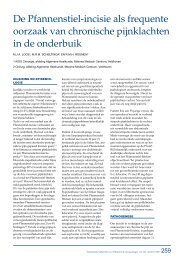Surgical management of chronic inguinal pain syndromes - Liespijn
Surgical management of chronic inguinal pain syndromes - Liespijn
Surgical management of chronic inguinal pain syndromes - Liespijn
You also want an ePaper? Increase the reach of your titles
YUMPU automatically turns print PDFs into web optimized ePapers that Google loves.
pensational costs in The Netherlands yearly.It should be appreciated that occupational disability affects about 1% <strong>of</strong> all operated<strong>inguinal</strong> hernia patients. Interestingly, occupational disability after hernia repair andappropriate <strong>management</strong> schemes have received very little attention. Yet, with respectto work resumption, a neurectomy seems to be effective in over 50% <strong>of</strong> the patients.Therefore, millions <strong>of</strong> euros for worker’s compensational and additional costs (replacement,loss <strong>of</strong> productivity, medical costs) may be saved if an effective treatment modalitysuch as a neurectomy is provided. When these figures are extrapolated globally,huge sums <strong>of</strong> money can be saved.The present study indicates that tailored neurectomy is an effective treatment foroccupational disability due to postherniorrhaphy <strong>inguinal</strong> neuralgia in over half <strong>of</strong> thepatients. A successful neurectomy greatly reduces workers’ compensational costs andmay have substantial financial consequences worldwide.CONCLUSIONS1. Chronic <strong>pain</strong> and functional impairment are common long-term complications after<strong>inguinal</strong> hernia repair and Pfannenstiel incisions.2. The VRS should be favoured over the VAS in future postherniorrhaphy <strong>pain</strong> assessment.3. Moderate to severe <strong>chronic</strong> <strong>pain</strong> after <strong>inguinal</strong> hernia repair can be classified intoneuropathic <strong>pain</strong> (50%), non-neuropathic <strong>pain</strong> (25%), and ‘funiculodynia’ (25%). Nerveentrapment is a frequent cause <strong>of</strong> <strong>chronic</strong> <strong>pain</strong> after a Pfannenstiel incision.4. Neurectomy provides substantial long-term <strong>pain</strong> relief in the majority <strong>of</strong> patients(50-75%) suffering from <strong>inguinal</strong> neuralgia after <strong>inguinal</strong> hernia repair or Pfannenstielincisions.5. Neurectomy is an (cost-)effective treatment modality for resolution <strong>of</strong> occupationaldisability due to postherniorrhaphy <strong>inguinal</strong> neuralgia.FUTURE PERSPECTIVESThe introduction <strong>of</strong> mesh techniques has reduced <strong>inguinal</strong> hernia recurrence rates spectacularly.However, some issues related to <strong>chronic</strong> <strong>pain</strong> are largely unknown. The body<strong>of</strong> evidence suggests that type <strong>of</strong> mesh or placement technique are not crucial for thedevelopment <strong>of</strong> <strong>pain</strong>. Therefore, which direction should future <strong>pain</strong> studies take?As some patients apparently are at risk for <strong>chronic</strong> <strong>pain</strong> development, it would behelpful to identify their characteristics preoperatively 27 . Some have found that geneticsusceptibility indeed is a risk factor for <strong>chronic</strong> <strong>pain</strong> development 6 . At present a fewgenotypes have been identified that may predispose for <strong>chronic</strong> <strong>pain</strong> states. Other ‘<strong>pain</strong>genes’ will likely be recognized in the near future, and this tendency could serve as abasis for preoperative identification <strong>of</strong> ‘<strong>pain</strong> individuals’. As a consequence, surgery maybe postponed in these individuals.Lately, numerous psychosomatic risk factors for chronification <strong>of</strong> <strong>pain</strong> have been identified.Among the most important determinants are long duration <strong>of</strong> the operation,high levels <strong>of</strong> acute postoperative <strong>pain</strong>, preoperative fear <strong>of</strong> surgery and optimism 28 .Prospective pre-operative identification with subsequent postoperative modulation <strong>of</strong>the most influential risk factors, may be worthwhile in preventing <strong>pain</strong> chronification.Future research may also focus on the identification <strong>of</strong> altered peripheral nerve signalling.The effects <strong>of</strong> <strong>inguinal</strong> neurectomy on various aspects <strong>of</strong> nerve signalling pathwaysmay give clues as to why this treatment is effective in some but not all individuals.Microglia in the dorsal horn are found to play a critical role in neuropathic <strong>pain</strong> 29 . Nerveinjury reduces microglial neuronal inhibition which may lead to a pathologically alteredsignalling pathway. Secondly, proinflammatory cytokines (IL-6) and sphingolipids havebeen found responsible for mechanical hypersensitivity 30 . Thirdly, neurotrophic factorsincluding nerve growth factor (NGF) act as peripheral <strong>pain</strong> mediators as well 31 . Infuture studies these and other substances may be chemically or histologically studiedin neurectomized nerve tissue. It may be hypothesized that different responses in thesesignalling pathways are related to clinical outcome.Various other clinical aspects <strong>of</strong> <strong>chronic</strong> <strong>pain</strong> mechanisms deserve further exploration.Some studies have assessed static quantative sensory testing (QST, measuring <strong>pain</strong>thresholds, magnitude levels and tolerance) in the prediction <strong>of</strong> direct postoperative<strong>pain</strong> or <strong>chronic</strong> postoperative <strong>pain</strong> 32 . Research suggests that certain QST patterns can belinked to somatosensory phenotypes which may mirror certain <strong>pain</strong> mechanisms. Thesecharacteristics may eventually result in a mechanism-based treatment, or may evenallow for a separation between successful patients and failures. However, the discriminativevalue <strong>of</strong> these tests as a means <strong>of</strong> <strong>chronic</strong> <strong>pain</strong> prediction is still under debate.The role <strong>of</strong> inter-individual differences in dynamic <strong>pain</strong> tests such as diffuse noxiousinhibitory controls (DNIC) may even be more promising 33 . DNIC describes the phenomenon<strong>of</strong> one noxious stimulus inhibiting the <strong>pain</strong> produced by a second. For instance,subjects may receive thermal and cold stimuli in a certain order after which perceivedDNIC is measured using questionnaires. A reduced DNIC may be related to hypersensitivityfor clinical <strong>pain</strong> and possibly also to its chronification 32 . These test panels maytherefore aid in selecting patients at risk for chronification <strong>of</strong> <strong>pain</strong>. If other risk factorsfor <strong>pain</strong> are involved as well, one may decide against operation such as <strong>inguinal</strong> herniarepair or a gynaecological procedure using a Pfannenstiel incision.Is there any room for future improvement in the imaging department? Neuro-imagingstudies may provide objective data on plasticity, sensitisation and certain amplificationprocesses 34 . Moreover, functional MRI may identify the locations <strong>of</strong> neural sensitisationand other amplification processes, and may relate these findings to <strong>pain</strong> experience144 Chapter 10Summarizing discussion, conclusions, and future perspectives 145





